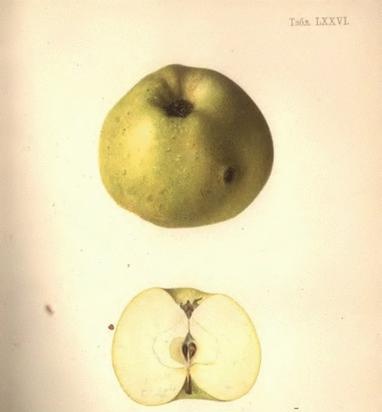|
 When winter comes, red apples of incredible size begin to appear in Siberian cities. Ten centimeters across. You can't eat one at once! When winter comes, red apples of incredible size begin to appear in Siberian cities. Ten centimeters across. You can't eat one at once!
Siberians in recent years have become accustomed to them and know that they bring whoppers from the south, from Kazakhstan, or rather, from Alma-Ata. Alma-Ata means Father of Apples. Where else could such colossus be born?
Meanwhile, an aport appeared in Alma-Ata relatively recently. It was bred in gardens in Ukraine and throughout Central Russia. Even in St. Petersburg. Only he brought his masters more trouble than good. When the tree was covered with fruit, they admired it. The apple tree promised a big harvest. The owner was already counting the profits. However, autumn was approaching, and there was almost nothing to collect. Somehow we did an interesting experiment. We compared Antonovka with an aport in the Kozelsky district of the Kaluga province. We chose trees of the same height. They took off the harvest. Antonovka gave forty-eight kilograms per circle, and aport only eight. They took me to the capital. Antonovka made an excellent trip to Moscow. The aport did not even reach Kaluga, it rotted all along the way.
We figured out what was the matter. Although the aport is beautiful, its flesh is fragile, loose. The skin is also weak. The wind will blow, the apple will hit the apple. The tissue will die. Rotting will begin. Worst when collecting. The fruit holds on to the branch tightly, you cannot immediately tear it off. Moreover, the leg is short. Until you get to her, you will break off the entire fruit-branch. Nature, of course, calculated correctly. She had not foreseen manual collection. It is important for her that the wind does not rip off. And rightly so. In the wind, the aport holds tenaciously and does not fall. If a storm rises, only then will it break away. And certainly with fruit.
 Apples bump on the branch and begin to rot. In addition, the design of the fruit has one very important flaw. From the nesting chamber in the center of the apple, where the seeds lie, a long thin tube extends outward. Air penetrates through it. And with it mold spores. Apples rot from two sides at once: from the middle and from the outside. They deteriorate quickly. Darkening and softening, they flop to the ground. In a damp autumn, and with a dense crown, half of the fruits collapses. Sometimes more. Every now and then you hear: slap, slap, slap ... For this, aport in Ukraine is called Shlopak. Apples bump on the branch and begin to rot. In addition, the design of the fruit has one very important flaw. From the nesting chamber in the center of the apple, where the seeds lie, a long thin tube extends outward. Air penetrates through it. And with it mold spores. Apples rot from two sides at once: from the middle and from the outside. They deteriorate quickly. Darkening and softening, they flop to the ground. In a damp autumn, and with a dense crown, half of the fruits collapses. Sometimes more. Every now and then you hear: slap, slap, slap ... For this, aport in Ukraine is called Shlopak.
The second problem is the attraction for the moth. The caterpillars of this butterfly prefer Shlopak to any other food, which again depends on the tenderness of the skin. Professor M. Rytov, the best connoisseur of Russian apples, lamented: "Under no other trees do you have to take such care of harvesting volunteers as under an aport." And it’s true, if you don’t remove it, the next harvest will also be lost.
Yet Shlopak was so handsome that these very noticeable flaws were forgiven him. It was grown everywhere in the Black Earth Region. And near Moscow. And even in St. Petersburg, at 60 degrees north latitude. But real fame came to the gentle creation only in the middle of the last century, when the Voronezh owner E. Redko, who moved to the city of Verny (now - Alma-Ata, Almaty), took with him the seedlings of this troublesome variety. The Vernensians were very surprised when, a few years later, they saw unusually large red apples in the garden of Redko. Their scent could be heard a few steps away.
Redko willingly shared his treasure with neighbors, and soon a new variety appeared among all Almaty residents. And then they found out about him in Moscow and St. Petersburg. They took the fruits to Siberia. Guzhom. For 700 miles! And south to the railroad. At the World Fruit Fair in Mannheim, the Vernensk Aport was admired by all.
And now I ask you to pay attention to what has just been said. The aport was transported so far, and it did not deteriorate. Previously, they could not deliver to Kaluga. And then 700 miles, to Siberia, and nothing! And they drove slowly, on horseback.And already to Mannheim, to Germany, in general, across the whole of Eurasia. If he had rotted, then he would not have got to the exhibition.
It turns out that the aport found ideal living conditions in Verny. He stopped being Shlopak. Is this not the answer to the mystery that still envelops the very name of the variety? The fact is that they still cannot decide how the word "aport" arose. Some say that from the city of Oporto (Porto) in Portugal. In due time it could be delivered from there. Others believe that from the exclamation "Aport, Polkan!", Which is addressed to the dog. This is completely incomprehensible.
And if you believe that our acquaintance was brought from Portugal, then where did he get to Portugal? Is it from the Kazakh mountains? This assumption may seem fantastic, but the mountains around Alma-Ata are still a living apple reserve. The Sivers apple tree grows there. Although it is wild, it gives quite decent, edible fruits. And what is even more important, an aport on a wild animal is perfectly grafted. The Sievers apple tree is used as the foundation of a cultivated tree. Like a stock. Why couldn't they have taken her out to Europe in the old days, how were the grapes taken out?
And now, in order to avoid misunderstandings, I confess. The aport has become so strong, and large, and tasty not all over Kazakhstan. But only on a small patch - in the vicinity of Alma-Ata. And in the Alma-Ata region. Outside this island, the aport is not the same. It becomes the most ordinary, the same ordinary apple, as in our Central Russia. What is the reason for this is not yet entirely clear.
The same luxurious look, albeit in a completely different way, is in the Crimean apple Kandil Sinapa. You cannot confuse Kandil with any other variety. He has his own shape of the fruit, not like others. It's like a barrel, slightly rounded and tapered at the ends. Almost cylindrical. The outlines are surprisingly symmetrical. The skin is finely lacquered with white wax, and this makes the whole fruit seem almost artificial, made of porcelain. The barrel, looking at the sun, is painted with a bright blush, slightly dimmed by a light matte coating.
 The pulp is juicy, wine-sweet and almost mealy. A tree covered with fruits looks like a luxurious chandelier on a sunny day. It is not for nothing that the word "kandil" in translation from Tatar means either a chandelier or a lamp. The pulp is juicy, wine-sweet and almost mealy. A tree covered with fruits looks like a luxurious chandelier on a sunny day. It is not for nothing that the word "kandil" in translation from Tatar means either a chandelier or a lamp.
Since Kandil is so good, one could expect that the whole Crimea was planted with this particular variety. In fact, Kandil occupies a secondary place in the Crimea. And in terms of the number of trees it is inferior to other varieties, which are much worse than him in taste and appearance. The reason is that the fruit is very unstable on the branches. The complete opposite of aport. You can't remove an aport from a branch, you can't keep Kandil! Candy barrels hang on thin twigs. A little breeze blew, not even a breeze, but marshmallows, the red-sided barrels moved, swayed and began to come off. At the top of the crown, the wind is stronger, and the top fruits are the first to pluck. Falling like a heavy drop, they hit those hanging below. Those immediately pour down and knock down the fruits of the lower floors. Etc. And now a real apple shower is making noise, caused by one fruit on the top of the head.
Woe to gardeners if a strong wind rises. He will bring complete devastation. Therefore, Kandil in Crimea is planted only in the most protected corners. And there are not so many of them in the Crimean mountainous country.
There is a second defect in Kandil. Long wait until the first apple. Twelve years after landing. And even all fifteen! But other varieties, it happens, begin to bear fruit three years old. True, Qandil then makes up for the delay. If it has bloomed, then the harvests go in bulk ...
Quite unexpectedly, this second defect was eliminated. Our glorious Michurin once took up Kandil. He just couldn't get past the barrel-shaped fruits. I decided to "sever" the Crimean masterpiece. For crossing, I matched him with a well-established Chinese woman. The hybrid came out extremely successful. Kandil-Chinese combined all the best from both parents. From Chinese - resistance to cold. From Kandil, his incomparable taste and festive porcelain look.
Michurin, of course, secretly hoped that it would be so. And since he was a master of his craft, expectations came true. But he could not foresee all the consequences of a bold step. These consequences could be both for the better and for the worse. The gardener was lucky. The juicy fruit of Kandil became even juicier. And the period of maturity of the tree, the period of the first fruiting was reduced by half. Instead of waiting 15 years, the first apple appears now in 6 or 8 years!
A. Smirnov. Tops and roots
Read now
All recipes
|
 When winter comes, red apples of incredible size begin to appear in Siberian cities. Ten centimeters across. You can't eat one at once!
When winter comes, red apples of incredible size begin to appear in Siberian cities. Ten centimeters across. You can't eat one at once! Apples bump on the branch and begin to rot. In addition, the design of the fruit has one very important flaw. From the nesting chamber in the center of the apple, where the seeds lie, a long thin tube extends outward. Air penetrates through it. And with it mold spores. Apples rot from two sides at once: from the middle and from the outside. They deteriorate quickly. Darkening and softening, they flop to the ground. In a damp autumn, and with a dense crown, half of the fruits collapses. Sometimes more. Every now and then you hear: slap, slap, slap ... For this, aport in Ukraine is called Shlopak.
Apples bump on the branch and begin to rot. In addition, the design of the fruit has one very important flaw. From the nesting chamber in the center of the apple, where the seeds lie, a long thin tube extends outward. Air penetrates through it. And with it mold spores. Apples rot from two sides at once: from the middle and from the outside. They deteriorate quickly. Darkening and softening, they flop to the ground. In a damp autumn, and with a dense crown, half of the fruits collapses. Sometimes more. Every now and then you hear: slap, slap, slap ... For this, aport in Ukraine is called Shlopak.






